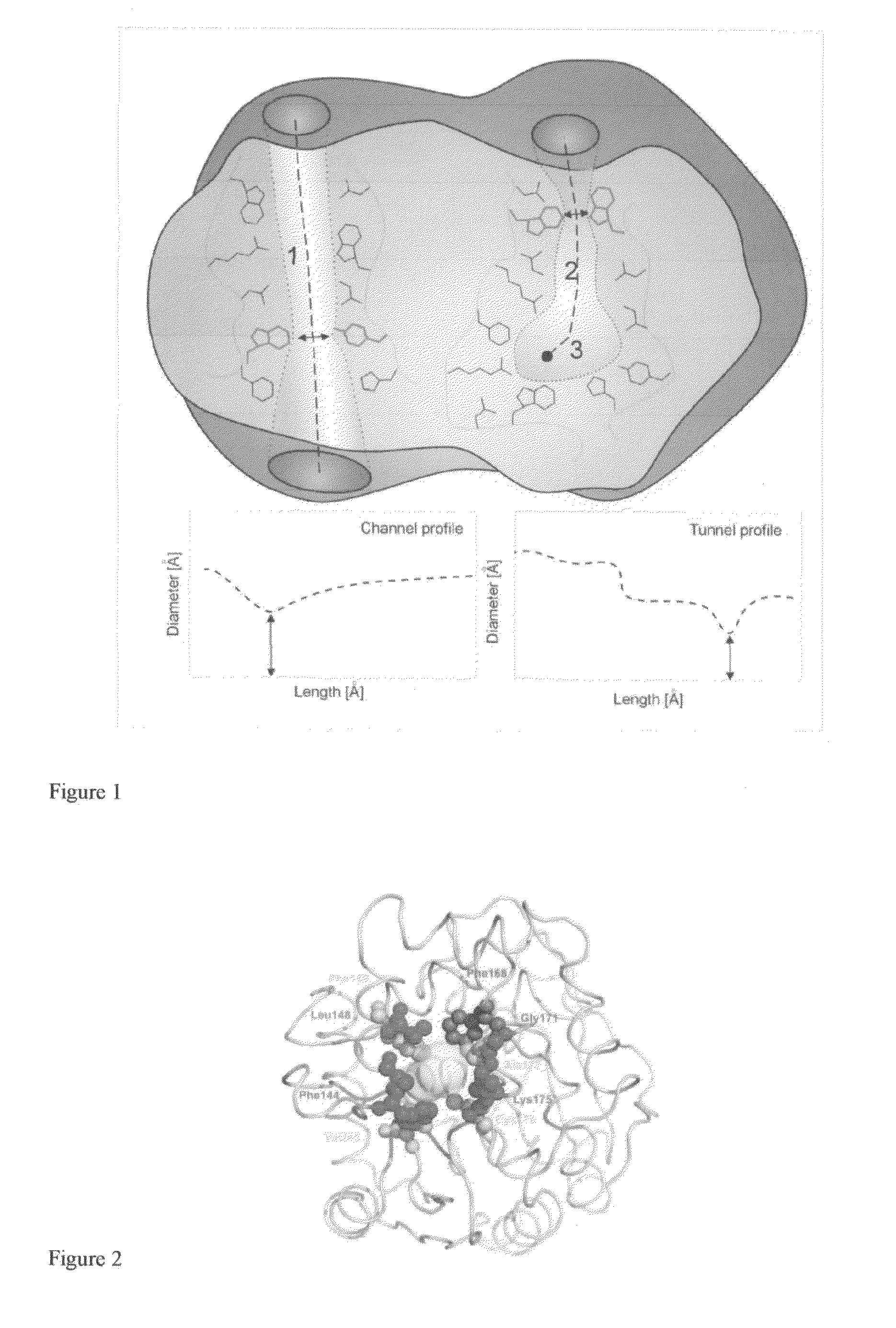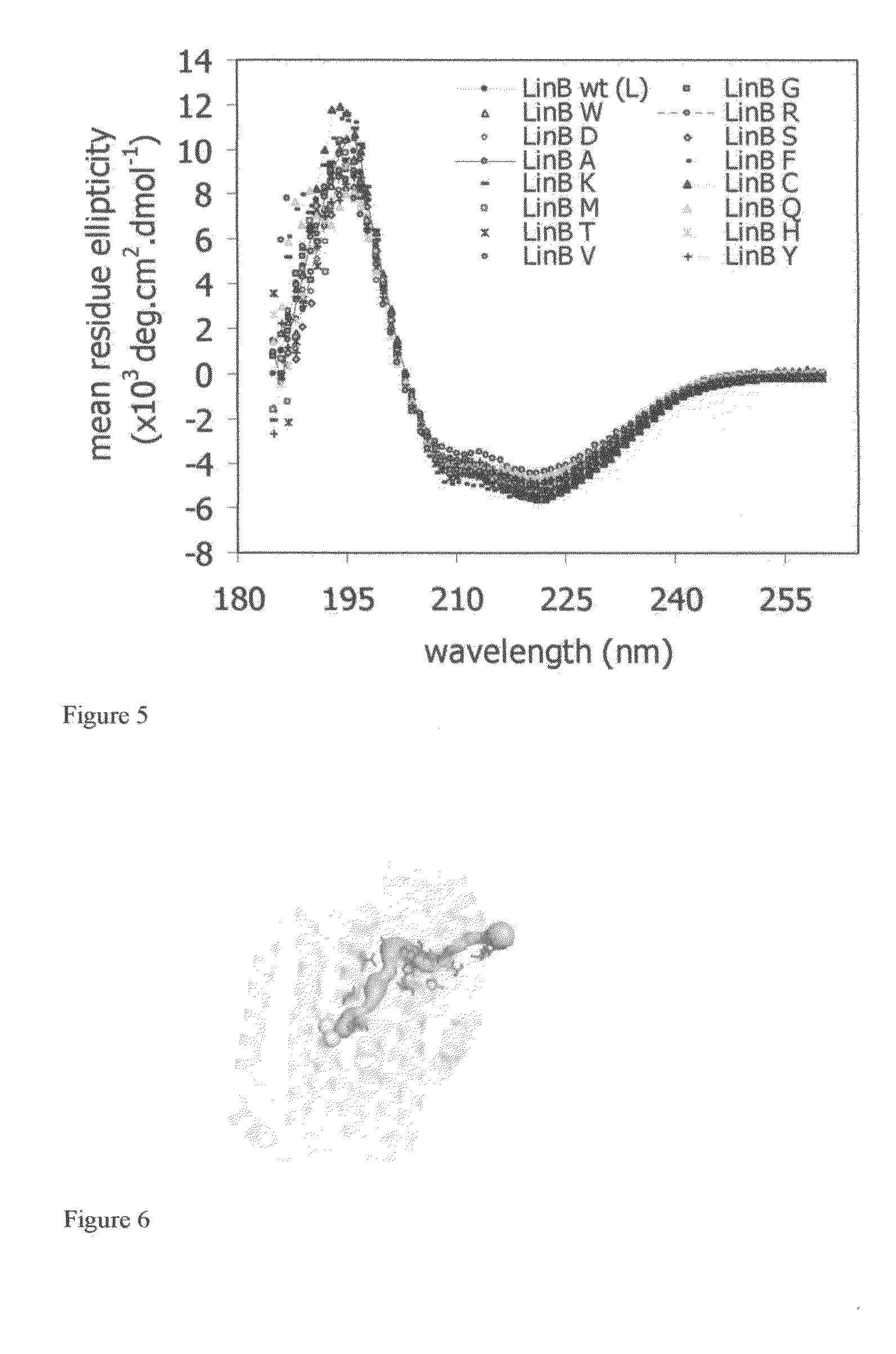Method of thermostabilization of a protein and/or stabilization towards organic solvents
a protein and organic solvent technology, applied in the field of protein modification, can solve the problems of poor solvent for most synthetic organic reactions, affecting the stability and activity of many enzymes, etc., and achieve the effects of reducing the intensity of mutagenesis, increasing the proportion of positive mutations in the created library, and increasing the thermal stability of the protein
- Summary
- Abstract
- Description
- Claims
- Application Information
AI Technical Summary
Benefits of technology
Problems solved by technology
Method used
Image
Examples
example 1
Engineering a Thermostable and Solvent Resistant Haloalkane Dehalogenase DhaA by Modification of Bottleneck in its Access Tunnel using a Combination of Rational Design and Directed Evolution
Introduction
[0033]Substitutions localized at the protein surface are believed to be structurally more acceptable than mutations in the enzyme interior and mostly without a detrimental effect on its activity (Eijsink, V. G. H., Gåseidnes, S., Borchert, T. V., a van den Burg, B. 2005: Directed evolution of enzyme stability. Biomolecular Engineering 22: 21-30). Less-frequently occurring tunnel residues represent a good target for mutagenesis. Substitutions in these natural hotspots (FIG. 2) do not disrupt the active site architecture accompanied by loss of functionality (Pavlova, M., Klvana, M., Prokop, Z., Chaloupkova, R., Banas, P., Otyepka, M., Wade, R. C., Tsuda, M., Nagata, Y., a Damborsky, J. 2009: Redesigning dehalogenase access tunnels as a strategy for degrading an anthropogenic substrate. ...
example 2
Engineering a Thermostable Haloalkane Dehalogenase LinB by Modification of Bottleneck Residue of its Access Tunnel using Rational Design
Introduction
[0048]The surface residue of the haloalkane dehalogenase LinB in the position 177 was selected for modification based on structural and phylogenetic analysis. This residue makes the bottleneck of the access tunnel and it is the most variable residue of the active site pocket among different haloalkane dehalogenases. Nineteen amino acid residues were introduced to the position 177 by random mutagenesis to investigate its effect on catalytic properties (Chaloupkova, R., Sykorova, J., Prokop, Z., Jesenska, A., Monincova, M., Pavlova, M., Tsuda, M., Nagata, Y., and Damborsky, J. 2003: Modification of activity and specificity of haloalkane dehalogenase from Sphingomonas paucimobilis UT26 by engineering of its entrance tunnel. Journal of Biological Chemistry 278: 52622-52628). Two protein variants (L177E and L177N) from nineteen prepared prote...
example 3
Design of Thermostable Proteins by Targeted Modifications of the Access Tunnels
Introduction
[0054]In this example, in silico design of protein variants with modified access tunnels and estimated effect of the mutations on protein stability is presented. Six enzymes (Table 3), possessing very different protein fold and enzymatic activity, were used in this study: methane monooxygenase (Elango, N., Radhakrishnan, R., Froland, W. A., Wallar, B. J., Earhart, C. A., Lipscomb, J. D., and Ohlendorf, D. H. 1997: Crystal structure of the hydroxylase component of methane monooxygenase from Methylosinus trichosporium OB3b, Protein Science 6: 556-568), type II cholesterol oxidase (Coulombe, R., Yue, K. Q., Ghisla, S., and Vrielink, A. 2001: Oxygen access to the active site of cholesterol oxidase through a narrow channel is gated by an Arg-Glu pair, Journal of Biological Chemistry 276: 30435-30441), Ni—Fe hydrogenase (Volbeda, A., Martin, L., Cavazza, C., Matho, M., Faber, B. W., Roseboom, W., Al...
PUM
| Property | Measurement | Unit |
|---|---|---|
| pH | aaaaa | aaaaa |
| pH | aaaaa | aaaaa |
| concentration | aaaaa | aaaaa |
Abstract
Description
Claims
Application Information
 Login to View More
Login to View More - R&D
- Intellectual Property
- Life Sciences
- Materials
- Tech Scout
- Unparalleled Data Quality
- Higher Quality Content
- 60% Fewer Hallucinations
Browse by: Latest US Patents, China's latest patents, Technical Efficacy Thesaurus, Application Domain, Technology Topic, Popular Technical Reports.
© 2025 PatSnap. All rights reserved.Legal|Privacy policy|Modern Slavery Act Transparency Statement|Sitemap|About US| Contact US: help@patsnap.com



